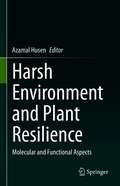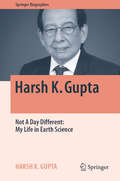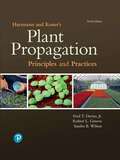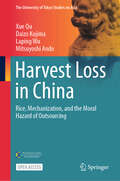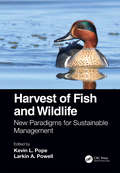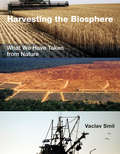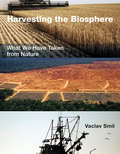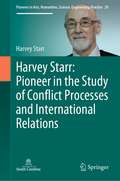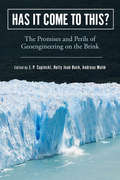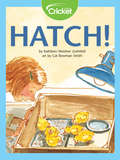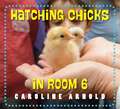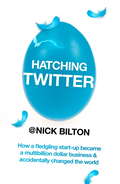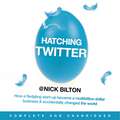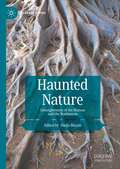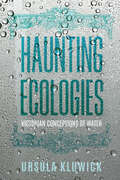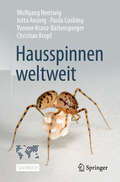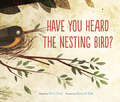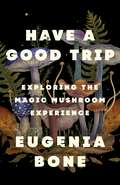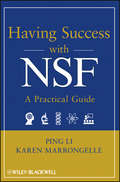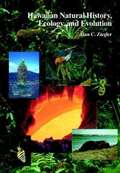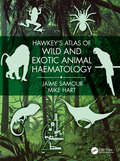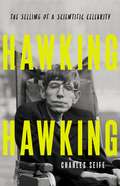- Table View
- List View
Harsh Environment and Plant Resilience: Molecular and Functional Aspects
by Azamal HusenIn the recent past, threats from climate change and unforeseeable environmental extremes to plant growth and productivity have consistently increased. The climate change-driven effects, especially from unpredictable environmental fluctuations, can result in an increased prevalence of abiotic and biotic stresses in plants. These stresses have slowed down the global yields of crop plants. On the other hand, food security for the rapidly growing human population in a sustainable ecosystem is a major concern of the present-day world. Thus, understanding the core developmental, physiological and molecular aspects that regulate plant growth and productivity in a challenging environment is a pivotal issue to be tackled by the scientific community dealing with sustainable agricultural and horticultural practices. Plants are influenced by the adverse environmental conditions at various levels, their different and diverse responses play a significant role in determining their growth, production and the overall geographical distribution. The chapters in this book focus on the biological mechanisms and fundamental principles that determine how different plant species grow, perform and interact with a challenging environment. This book covers a broad range of topics in plant science, including gene function, molecules, physiology, cell biology and plant ecology, to understand the functioning of plants under harsh environmental conditions. The book elucidates the physiological and molecular mechanisms in different plant species, ecophysiological interactions of plants, interplay between plant roots, arbuscular mycorrhizal fungi and plant growth-promoting rhizobacteria, biosensors for monitoring stress, production of secondary metabolites, stress alleviation processes, and more.
Harsh K. Gupta: Not A Day Different: My Life in Earth Science (Springer Biographies)
by Harsh K. GuptaThis book captures the essence of one of the most remarkable journeys of a professional who prevailed over numerous challenges and adverse situations that appeared before him from nowhere and how he emerged victorious to be hailed at a global forum of the American Geophysical Union in 2008. The author reflects upon the circumstances and times in post-independent India that threw him out of the comforts of a well-to-do family into the real world. He traces back his entry into the field of earthquake science and dwells at length upon the scope and freedom it offered for innovative thinking in the field with limitless opportunities. Mishaps and accidents paved the way to remarkable discoveries and achievements including the creation of the world record for establishing and populating India’s first permanent base station in Antarctica in a record time of one Antarctic summer despite having a near-fatal helicopter crash on 4th day after reaching Antarctica. Stressing the need to live safely with earthquakes as their short-term prediction is not a possibility yet, the author advocates a two-prong strategy of directly looking into the earthquake source region deep inside the earth and developing an earthquake-resilient society, simultaneously. He cites the success story of the Indian Tsunami Early Warning System that is operational in the Indian Ocean, today. The book inspires young professionals with a flair for challenges and a burning desire to achieve results at any cost. This book provides important information in a nutshell about artificial water reservoir triggered earthquakes, India’s building of the Dakshin Gangotri all-weather station in Antarctica, Indian Ocean Tsunami warning set-up, Low-Temperature Thermal Desalination, etc. The main objective of the book is to inspire a generation of young minds through a narration of scientific achievements that did not come easily to him. The aim is to tell them the difference between a reaction and a response to a given situation, the former being impulsive and irrational and the latter responsible and rational.
Hartmann and Kester's Plant Propagation: Principles and Practices
by Robert Geneve Sandra Wilson Hudson Hartmann Dale Kester Fred DaviesFor all undergraduate courses in plant propagation at the two-year and four-year colleges and universities. <p><p>The world standard for plant propagation and horticulture for over 50 years, Hartmann and Kester’s Plant Propagation continues to be the field’s most complete, up-to-date text on plant propagation. It now contains color figures throughout, promoting learning and making it an even more useful working text and reference. It also contains extensive updates reflecting the latest commercial techniques and understanding of propagation biology. Like previous editions, it is organized into paired chapters on principles and practices, so it can easily be adapted for teaching courses that cover only practical topics, and for courses that also cover conceptual issues.
Harvest Loss in China: Rice, Mechanization, and the Moral Hazard of Outsourcing (The University of Tokyo Studies on Asia)
by Xue Qu Daizo Kojima Laping Wu Mitsuyoshi AndoThis open access book examines food security in China with a specific focus on rice harvesting. As the most populous agricultural developing country, China’s food security is closely related to the world’s food security. An urgent issue internationally, data show that every year, about one-third of food is lost and wasted before it even reaches the market, mainly in less developed countries. To this end, halving the amount of food loss and waste is one of the Sustainable Development Goals. In 2021, the Chinese government issued the Anti-Food Waste Law of the People’s Republic of China, placing a high priority on food loss reduction. Rice, one of the major staple foods, has also received a higher priority in government policy, as it has been deemed required to be “absolutely safe”. In China, rice farmers rely heavily on outsourcing services to complete harvesting, which has led to the rapid development of mechanical harvesting. This book shows that the essence of outsourcing services is a principal–agent relationship in which there is a potential moral hazard, which is considered detrimental to harvest losses. The book analyses the effect of the moral hazard in harvest outsourcing services on rice harvest losses from this principal–agent theoretical perspective. Using the latest nationwide farmer survey, it empirically demonstrates the moral hazard in agricultural outsourcing services and its negative impact on harvest losses, providing suggestions for food loss reduction in China and similar developing countries where agricultural outsourcing services are developing rapidly. Relevant to social science researchers working in areas of food security in connection with the SDGs, and to scholars studying development in China more generally, this is a timely contribution confronting possible means of food loss reduction, in the developing world particularly, in the East, and globally.
Harvest of Fish and Wildlife: New Paradigms for Sustainable Management
by Kevin L. PopeHarvest of Fish and Wildlife: New Paradigms for Sustainable Management unites experts in wildlife and fishery sciences for an interdisciplinary overview of harvest management. This book presents unique insights for embracing the complete social-ecological system to ensure a sustainable future. It educates users on evolutionary and population dynamics; social and political influences; hunter and angler behavior; decision processes; impacts of regulations; and stakeholder involvement. Features: Written by twenty-four teams of leading scientists and managers. Promotes transparent justification for fishing and hunting regulations. Provides examples for integrating decision making into management. Emphasizes creativity in management by integrating art and science. This book appeals to population biologists, evolutionary biologists and social scientists. It is a key resource for on-the-ground managers and research scientists developing harvesting applications. As the book’s contributors explain: “Making decisions that are robust to uncertainty…is a paradigm shift with a lot of potential to improve outcomes for fish and wildlife populations.” –Andrew Tyre and Brigitte Tenhumberg “Temporal shifts in system states…must somehow be anticipated and dealt with to derive harvest policies that remain optimal in the long term.” –Michael Conroy “Proactive, effective management of sportspersons…will be essential in the new paradigm of harvest management.” –Matthew Gruntorad and Christopher Chizinski
Harvest the Wind: America's Journey to Jobs, Energy Independence, and Climate Stability
by Philip WarburgWinds sweeping across the Great Plains once robbed the Farm Belt of its future, stripping away overworked topsoil and creating the dreaded Dust Bowl of the 1930s. Today, those winds are bringing new hope to the declining rural communities of the central United States. Nowhere is wind's promise more palpable than in Cloud County, Kansas, home to the Meridian Way Wind Farm, whose turbines are boosting farm incomes and bringing green jobs to a community that has watched its children flock elsewhere. Modern wind power is the best thing to hit this stretch of midwestern prairie since the Union Pacific railroad.In Harvest the Wind, Warburg brings us the people behind the green economy-powered resurgence in Cloud County and communities like it across the United States. This corner of Kansas is the first stop on an odyssey that introduces readers to farmers, factory workers, biologists, and high-tech entrepreneurs--all players in a transformative industry that is taking hold across America and around the globe.Harvest the Wind serves as an earthly antidote to the more abstract treatises on global warming and green energy. By showing us how practical solutions are being implemented at the local level, Warburg offers an inspirational look at how we can all pursue a saner and more sustainable energy future.
Harvesting Solar Energy: Using CO₂ and H₂O as Energy Storage Materials (Green Energy and Technology)
by Ibram GaneshThis book presents artificial photosynthesis (AP) that facilitates the capture and storage of solar energy in order to meet our energy needs. Furthermore, renewable carbon-neutral high-energy-density liquid fuels used in the present existing energy distribution infrastructure can also be synthesized by following the AP process using carbon dioxide, water, and electricity derived from sunlight. The only way to make energy, environment, economy, and life sustainable is to harvest sunlight to meet the energy needs of society by using carbon dioxide and water as for energy storage.
Harvesting the Biosphere: What We Have Taken from Nature
by Vaclav SmilThe biosphere -- the Earth's thin layer of life -- dates from nearly four billion years ago, when the first simple organisms appeared. Many species have exerted enormous influence on the biosphere's character and productivity, but none has transformed the Earth in so many ways and on such a scale as Homo sapiens. In Harvesting the Biosphere, Vaclav Smil offers an interdisciplinary and quantitative account of human claims on the biosphere's stores of living matter, from prehistory to the present day. Smil examines all harvests -- from prehistoric man's hunting of megafauna to modern crop production -- and all uses of harvested biomass, including energy, food, and raw materials. Without harvesting of the biomass, Smil points out, there would be no story of human evolution and advancing civilization; but at the same time, the increasing extent and intensity of present-day biomass harvests are changing the very foundations of civilization's well-being.In his detailed and comprehensive account, Smil presents the best possible quantifications of past and current global losses in order to assess the evolution and extent of biomass harvests. Drawing on the latest work in disciplines ranging from anthropology to environmental science, Smil offers a valuable long-term, planet-wide perspective on human-caused environmental change.
Harvesting the Biosphere: What We Have Taken from Nature
by Vaclav SmilAn interdisciplinary and quantitative account of human claims on the biosphere's stores of living matter, from prehistoric hunting to modern energy production.The biosphere—the Earth's thin layer of life—dates from nearly four billion years ago, when the first simple organisms appeared. Many species have exerted enormous influence on the biosphere's character and productivity, but none has transformed the Earth in so many ways and on such a scale as Homo sapiens. In Harvesting the Biosphere, Vaclav Smil offers an interdisciplinary and quantitative account of human claims on the biosphere's stores of living matter, from prehistory to the present day. Smil examines all harvests—from prehistoric man's hunting of megafauna to modern crop production—and all uses of harvested biomass, including energy, food, and raw materials. Without harvesting of the biomass, Smil points out, there would be no story of human evolution and advancing civilization; but at the same time, the increasing extent and intensity of present-day biomass harvests are changing the very foundations of civilization's well-being.In his detailed and comprehensive account, Smil presents the best possible quantifications of past and current global losses in order to assess the evolution and extent of biomass harvests. Drawing on the latest work in disciplines ranging from anthropology to environmental science, Smil offers a valuable long-term, planet-wide perspective on human-caused environmental change.
Harvey Starr: Pioneer in the Study of Conflict Processes and International Relations (Pioneers in Arts, Humanities, Science, Engineering, Practice #29)
by Harvey StarrThis book sets out, through Starr’s personal story, his interest in how the ideas of “intellectual trajectories” and “political memories” could be incorporated into intellectual autobiography, thus exploring how the personal lives of individual academics intersected with their professional interests. By following the development of his approach to research, interdisciplinarity, the logic of inquiry, and the opportunity and willingness framework scholars and researchers will see how his groundbreaking research in Conflict Processes and International Relations Theory developed and were interlinked (especially diffusion, geography and spatiality; the democratic peace and integration; decision making). In addition, graduate students and junior faculty should find useful hints about how to navigate their way through the complexities of becoming both a professional and successful academic and scholar.• This book provides the most complete treatment of the work and contributions of Harvey Starr, a former President of the International Studies Association. • Important for contemporary students of international relations, and their understanding of IR theory and methods.• Demonstrates an eclectic linking of theoretical, logical, and empirical approaches to the study of IR—providing a critical logic of inquiry to do research.• Provides insights and blueprints for how to develop interdisciplinary and multidisciplinary scholarship, highlighting geography and social-psychology.• Affords graduate students and recent Ph.D.s guidance in the development of research, becoming a professional, and the choices to be made in one’s academic career.
Has Feminism Changed Science?
by Londa SchiebingerDo women do science differently? And how about feminists--male or female? The answer to this fraught question, carefully set out in this provocative book, will startle and enlighten every faction in the "science wars." Has Feminism Changed Science? is at once a history of women in science and a frank assessment of the role of gender in shaping scientific knowledge. Science is both a profession and a body of knowledge, and Londa Schiebinger looks at how women have fared and performed in both instances. She first considers the lives of women scientists, past and present: How many are there? What sciences do they choose--or have chosen for them? Is the professional culture of science gendered? And is there something uniquely feminine about the science women do? Schiebinger debunks the myth that women scientists--because they are women--are somehow more holistic and integrative and create more cooperative scientific communities. At the same time, she details the considerable practical difficulties that beset women in science, where domestic partnerships, children, and other demanding concerns can put women's (and increasingly men's) careers at risk. But what about the content of science, the heart of Schiebinger's subject? Have feminist perspectives brought any positive changes to scientific knowledge? Schiebinger provides a subtle and nuanced gender analysis of the physical sciences, medicine, archaeology, evolutionary biology, primatology, and developmental biology. She also shows that feminist scientists have developed new theories, asked new questions, and opened new fields in many of these areas.
Has It Come to This?: The Promises and Perils of Geoengineering on the Brink (Nature, Society, and Culture)
by Christian Parenti Richard York Jennie C. Stephens David Tyfield Laurence L. Delina Tina Sikka Nils Markusson Duncan McLaren Wim Carton Lili Fuhr Mads Dahl Gjefsen Ina Möller Anne Pasek Linda Schneider Kevin Surprise Kyle Powys WhyteGeoengineering is the deliberate and large-scale intervention in the Earth's climate system in an attempt to mitigate the adverse effects of global warming. Now that climate emergency is upon us, claims that geoengineering is inevitable are rapidly proliferating. How did we get into this situation where the most extreme path now seems a plausible development? Is it an accurate representation of where we are at? Who is this “we” who is talking? What options make it onto the table? Which are left out? Whom does geoengineering serve? Why is the ensemble of projects that goes by that name so salient, even though the community of researchers and advocates is remarkably small? These are some of the questions that the thinkers contributing to this volume are exploring from perspectives ranging from sociology and geography to ethics and Indigenous studies. The editors set out this diverse collection of voices not as a monolithic, unified take on geoengineering, but as a place where creative thinkers, students, and interested environmental and social justice advocates can explore nuanced ideas in more than 240 characters.
Hatch!
by Kathleen Weidner ZoehfeldLearn about how eggs grow and hatch, and how baby chickens can be hatched using an incubator.
Hatching Chicks in Room 6 (Life Cycles in Room 6)
by Caroline ArnoldKindergarteners learn the joys of hatching chicks from egg to coop in this close-up look at how chickens grow. A visit to Mrs. Best's classroom is always inspiring! Follow a classroom of real kindergartners as they participate in a popular activity: hatching chicks. Astonishing photographs show the life cycle of a chicken, from incubating eggs, watching them hatch, and raising the chicks until they are old enough to return to the chicken coop.The Life Cycles in Room 6 series follows Mrs. Best&’s real kindergarten class as they help things grow. This photo-illustrated series engages readers with hands-on science in the classroom and beyond.Winner of the Cybils Award for Elementary NonfictionArnold captures the joy and mystery of this familiar unit of study — Kirkus ReviewsReaders will come away with a good understanding of chickens' origins — BooklistAn excellent addition to studies of animals, life cycles, or agriculture, as well as an excellent mentor text for the genre of photo essay and stories of classroom life. — SLJ's Classroom Bookshelf Blog
Hatching Twitter: A True Story of Money, Power, Friendship and Betrayal
by Nick Bilton'A tale of Machiavellian plots and coups d'etat, it's just all so gripping' Chris Evans, BBC Radio 2THE ULTIMATE 21ST CENTURY BUSINESS STORYSince 2006, Twitter has grown from the accidental side project of a failing internet start-up, to a global icon that by 2013 had become an $11.5bn business. But the full story of Twitter's hatching has never been told before.In his revelatory new book, New York Times journalist Nick Bilton takes readers behind the scenes of Twitter as it grew at exponential speeds, and inside the heads of the four hackers who created it: ambitious millionaire Evan Williams; tattooed mastermind Jack Dorsey; joker and diplomat Biz Stone; and Noah Glass, the shy but energetic geek who invested his whole life in Twitter, only to be kicked out and expunged from the company's official history.Combining unprecedented access with exhaustive investigative reporting, and drawing on hundreds of sources, documents and internal emails, New York Times' bestseller HATCHING TWITTER is a blistering drama of betrayed friendships and high-stakes power struggles. A business story like no other, it will shock, expose and inspire.
Hatching Twitter: A True Story of Money, Power, Friendship and Betrayal
by Nick BiltonTHE ULTIMATE 21ST CENTURY BUSINESS STORYEv told Jack he had to 'chill out' with the deluge of media he was doing. 'It's bad for the company,' Ev said. 'It's sending the wrong message.' Biz sat between them, watching like a spectator at a tennis match.'But I invented Twitter,' Jack said.'No, you didn't invent Twitter,' Ev replied. 'I didn't invent Twitter either. Neither did Biz. People don't invent things on the Internet. They simply expand on an idea that already exsists.'Since 2006, Twitter has grown from the accidental side project of a failing internet start-up, to a global icon that by 2013 had become an $11.5bn business. But the full story of Twitter's hatching has never been told before.In his revelatory new book, New York Times journalist Nick Bilton takes readers behind the scenes of Twitter as it grew at exponential speeds, and inside the heads of the four hackers who created it: ambitious millionaire Evan Williams; tattooed mastermind Jack Dorsey; joker and diplomat Biz Stone; and Noah Glass, the shy but energetic geek who invested his whole life in Twitter, only to be kicked out and expunged from the company's official history.Combining unprecedented access with exhaustive investigative reporting, and drawing on hundreds of sources, documents and internal e-mails, HATCHING TWITTER is a blistering drama of betrayed friendships and high-stakes power struggles. A business story like no other, it will shock, expose and inspire.(P)2013 Penguin Group USA
Haunted Nature: Entanglements of the Human and the Nonhuman (Palgrave Gothic)
by Sladja BlazanThis volume is a study of human entanglements with Nature as seen through the mode of haunting. As an interruption of the present by the past, haunting can express contemporary anxieties concerning our involvement in the transformation of natural environments and their ecosystems, and our complicity in their collapse. It can also express a much-needed sense of continuity and relationality. The complexity of the question—who and what gets to be called human with respect to the nonhuman—is reflected in these collected chapters, which, in their analysis of cinematic and literary representations of sentient Nature within the traditional gothic trope of haunting, bring together history, race, postcolonialism, and feminism with ecocriticism and media studies. Given the growing demand for narratives expressing our troubled relationship with Nature, it is imperative to analyze this contested ground.
Haunting Ecologies: Victorian Conceptions of Water (Victorian Literature and Culture Series)
by Ursula KluwickVictorians&’ views of water and its role in how the social fabric of Victorian Britain was imagined Water matters like few other substances in people&’s daily lives. In the nineteenth century, it left its traces on politics, urban reform, and societal divisions, as well as on conceptualizations of gender roles. Drawing on the methodology of material ecocriticism, Ursula Kluwick&’s Haunting Ecologies argues that Victorian Britons were keenly aware of aquatic agency, recognizing water as an active force with the ability to infiltrate bodies and spaces. Kluwick reads works by canonical writers such as Braddon, Dickens, Stoker, and George Eliot alongside sanitary reform discourse, court cases, journalistic articles, satirical cartoons, technical drawings, paintings, and maps. This wide-ranging study sheds new light on Victorian-era anxieties about water contamination as well as on how certain wet landscapes such as sewers, rivers, and marshes became associated with moral corruption and crime. Applying ideas from the field of blue humanities to nineteenth-century texts, Haunting Ecologies argues for the relevance of realism as an Anthropocene form.
Hausspinnen weltweit
by Wolfgang Nentwig Jutta Ansorg Christian Kropf Paula Cushing Yvonne Kranz-BaltenspergerSpinnen, die als Untermieter in unseren Häusern vorkommen, werden meist ignoriert und gelegentlich (zu Unrecht) gefürchtet. Es dürfte weltweit kaum ein Gebäude geben, in dem nicht einige Spinnenarten vorkommen. Faszinierend daran ist, dass es immer wieder die gleichen Arten sind. Sie verfügen über besondere Anpassungen, denn die Luftfeuchtigkeit ist viel zu gering, es ist zu sauber und das Nahrungsangebot ist knapp. Wer aber den Sprung in unsere vier Wände geschafft hat, wird mit einem globalen Bleiberecht belohnt. Das liegt an der weltweiten Handels- und Migrationsfreudigkeit der Menschen: Sie transportieren einen unendlichen Strom von Waren um die Welt. Und unsere Hausspinnen reisen unerkannt mit. Es ist daher möglich, die weltweit anzutreffenden Hausspinnen in einem einzigen Buch vorzustellen, denn es sind überall weitgehend die gleichen. Die rund 50 wichtigsten Arten und Artengruppen werden mit einem ausführlichen Steckbrief, Fotos und Verbreitungskarten in allgemeinverständlicher Weise vorgestellt.
Have You Heard the Nesting Bird?
by Rita GrayWoodpecker calls from a tree, "cuk-cuk-cuk." Starling sings, "whistle-ee-wee." But have you heard the nesting bird? In this book, we hear all the different bird calls in counterpoint to the pervasive quiet of a mama bird waiting for her eggs to hatch. Fun and informative back matter takes the shape of an interview so that readers learn more right from the bird's bill. Ken Pak's lively illustrations, paired with Rita Gray's words, render a visual and sonorous picture book to be enjoyed by young naturalists.
Have a Good Trip: Exploring the Magic Mushroom Experience
by Eugenia BoneFrom a much-loved expert and popular science writer comes this straight-from-the-trenches report on how and why folks from all walks of life are using magic mushrooms to enhance their lives.Interest in psychedelic mushrooms has never been greater – or the science less definitive. Popular science writer and amateur mycologist Eugenia Bone reports on the state of psychedelics today, from microdosing to heroic trips, illustrating how “citizen science” and anecdotal accounts of the mushrooms’ benefits are leading the new wave of scientific inquiry into psilocybin. With her signature blend of first-person narrative and scientific rigor, Bone breaks down just how the complicated cocktail of psychoactive compounds is thought to interact with our brain chemistry. She explains how mindset and setting can impact a trip – whether therapeutic, spiritual/mystical, or simply pleasure seeking – and vividly evokes the personalities and protocols that populate the tripping scene, from the renegade “’Noccers” of Washington who merrily disperse magic mushroom spores around Seattle, to the indigenous curanderas who conduct traditional ceremonies in remote Mexican villages. Throughout she shares her journey through the world of mushrooms, cultivating her own stash, grappling with personal challenges, and offering the insights she gleaned from her experiences. For both seasoned trippers and the merely mushroom curious, Have a Good Trip offers a balanced, entertaining, and provocative look at this rapidly evolving cultural phenomenon.
Having Success with NSF
by Ping Li Karen MarrongelleThis book is designed to help researchers achieve success in funding their National Science Foundation (NSF) research proposals. The book discusses aspects of the proposal submission and review process that are not typically communicated to the research community. Written by authors with successful track records in grant writing and years of experience as NSF Program Directors, this book provides an insider's view of successful grantsmanship. Written in a practical approach, this book offers tips that will not be found in official paperwork and provides answers to questions frequently asked of NSF Program Directors. The purpose of the book is to improve your NSF grant-writing skills and improve your chances of funding.
Hawaiian Natural History, Ecology, and Evolution
by Alan C. ZieglerNot since Willam A. Bryans 1915 landmark compendium, Hawaiian Natural History, has there been a single-volume work that offers such extensive coverage of this complex but fascinating subject. Hawaiian Natural History, Ecology, and Evolution updates both the earlier publication and subsequent works by compiling and synthesizing in a uniform and accessible fashion the widely scattered information now available. An extensive annotated bibliography and a list of audio-visual materials will help readers locate additional sources of information.
Hawkey's Atlas of Wild and Exotic Animal Haematology
by Jaime Samour Mike HartThis revised, updated and expanded edition of Christine Hawkey’s A Colour Atlas of Comparative Veterinary Haematology is bursting with high-quality images to aid identification of blood cells and haemoparasites in the different species commonly seen in private practice and zoological collections. It will assist veterinarians in the identification of normal and abnormal blood cells and in understanding the structural differences of blood cells between the various taxa within the Animal Kingdom. With the help of this guide, readers will be able to understand haemoresponses in the presence of specific and non-specific disease processes and identify haemoparasites commonly seen in blood films from wild and exotic animals. This impressively illustrated comparative haematology atlas is unrivalled in its scope, quality and accuracy. It is a must-have for veterinary students, veterinary surgeons working in general and referral veterinary clinical practices, clinicians working in zoological collections and specialists in exotic animal medicine.
Hawking Hawking: The Selling of a Scientific Celebrity
by Charles SeifeStephen Hawking was widely recognized as the world's best physicist and even the most brilliant man alive–but what if his true talent was self-promotion?When Stephen Hawking died, he was widely recognized as the world's best physicist, and even its smartest person. He was neither. In Hawking Hawking, science journalist Charles Seife explores how Stephen Hawking came to be thought of as humanity's greatest genius. Hawking spent his career grappling with deep questions in physics, but his renown didn't rest on his science. He was a master of self-promotion, hosting parties for time travelers, declaring victory over problems he had not solved, and wooing billionaires. In a wheelchair and physically dependent on a cadre of devotees, Hawking still managed to captivate the people around him—and use them for his own purposes. A brilliant exposé and powerful biography, Hawking Hawking uncovers the authentic Hawking buried underneath the fake. It is the story of a man whose brilliance in physics was matched by his genius for building his own myth.
